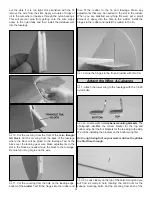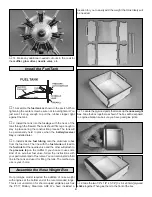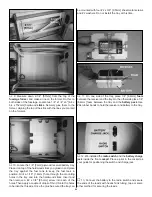
reasonably scale appearance without the hassles typically
associated with flying wires. Because they are made from
elastic there is no need to tension them each time you put
the plane together. These wires will add approximately two
minutes to the overall assembly time of the plane at the
flying field.
❏ ❏
1. Measure from the fillet at the trailing edge of the
stab out toward the tip of the stab 6-1/2" [165mm] and make
a mark with a felt-tip pen. Measure in from the trailing edge
of the stab 1/4" [6.4mm] and make a crossing mark. Do the
same on the leading edge of the stab. Do this on both sides
of the stab.
❏ ❏
2. At the rear corner of the fin, measure down and in
1/8" [3mm]. From the intersection of those lines make a
mark on the front of the fin 3-1/8" [79mm]. On the marks,
drill a hole through the fin with a 5/64" [2mm] drill.
❏ ❏
3. Drill a 5/64" [2mm] hole through the block at the
back of the fuselage.
❏ ❏
4. Cut a piece of the elastic cord 50" [1270mm] long.
This length should be relaxed, not stretched. In order to feed
the elastic cord through the holes you have drilled, apply a
few drops of thin CA to one end of the elastic cord, covering
approximately 1" [25mm] of the cord. On the opposite end of
the cord put a small drop of CA, just enough to make the
end of the cord hard. On this end of the cord, apply a small
drop of CA to the end and insert it into the hole in the block.
Hold the cord in place until the glue cures. Thread the
opposite end of the cord through the hole in the leading
edge of the stab as shown.
❏ ❏
5. Thread the cord through the hole in the leading
edge of the fin.
❏ ❏
6. Continue threading the cord through the hole in the
leading edge of the stab on the opposite side of the fuselage.
27










































